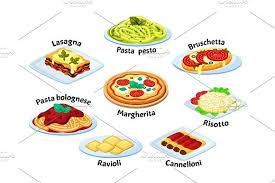Exploring the Delights of Traditional Italian Food
Italian cuisine is renowned worldwide for its rich flavors, fresh ingredients, and time-honored traditions. Traditional Italian food is a celebration of simplicity, quality, and passion for cooking that has been passed down through generations.
One of the hallmarks of traditional Italian cuisine is its regional diversity. Each region in Italy boasts its own culinary specialties, influenced by local produce, climate, and cultural heritage. From the hearty pasta dishes of the north to the seafood-rich creations of the south, every bite tells a story of Italy’s vibrant culinary landscape.
Pasta is an iconic staple in traditional Italian food. Whether it’s al dente spaghetti alle vongole from Naples or creamy fettuccine alfredo from Rome, pasta dishes are a beloved part of Italian gastronomy. Pair them with homemade sauces bursting with flavors from fresh tomatoes, basil, olive oil, and garlic for an authentic taste of Italy.
Antipasti, such as bruschetta topped with ripe tomatoes and basil or prosciutto-wrapped melon, tantalize the taste buds before the main course. Followed by hearty mains like osso buco (braised veal shanks) or classic risotto alla Milanese (saffron-infused risotto), traditional Italian meals are a symphony of flavors and textures.
No Italian meal is complete without a sweet ending. Indulge in tiramisu layered with coffee-soaked ladyfingers and mascarpone cheese or cannoli filled with sweet ricotta cream – these desserts capture the essence of la dolce vita.
Italian cuisine places a strong emphasis on using fresh, seasonal ingredients to create dishes that are both delicious and nutritious. Olive oil, tomatoes, garlic, herbs, and cheeses like Parmigiano-Reggiano are staples in Italian cooking that lend depth and complexity to every dish.
Whether you’re dining at a rustic trattoria in Tuscany or a bustling osteria in Sicily, traditional Italian food offers a sensory journey that celebrates the artistry of home-cooked meals made with love. It’s not just about eating; it’s about savoring each bite and sharing moments of joy around the table.
Top 5 Frequently Asked Questions About Traditional Italian Food
- What are some popular traditional Italian dishes?
- How is traditional Italian pasta made?
- What are common ingredients used in traditional Italian cooking?
- What is the significance of regional differences in Italian cuisine?
- Can you recommend authentic Italian restaurants known for traditional dishes?
What are some popular traditional Italian dishes?
When exploring traditional Italian cuisine, you’ll encounter a rich tapestry of beloved dishes that have stood the test of time. Some popular traditional Italian dishes include classic pasta favorites like spaghetti carbonara, lasagna, and ravioli. Risotto alla Milanese, a creamy saffron-infused rice dish from Milan, and Osso Buco, tender braised veal shanks served with gremolata, are also highly regarded. Additionally, iconic antipasti such as bruschetta topped with fresh tomatoes and basil or prosciutto-wrapped melon showcase the simplicity and elegance of Italian flavors. To satisfy your sweet tooth, don’t miss out on indulgent desserts like tiramisu and cannoli that perfectly encapsulate the sweet side of traditional Italian gastronomy.
How is traditional Italian pasta made?
Traditional Italian pasta is crafted with care and expertise, following a time-honored process that has been perfected over centuries. The key ingredients are simple – flour, water, and sometimes eggs – but the magic lies in the technique. The dough is kneaded to the perfect consistency, rolled out into thin sheets, and then cut into various shapes like spaghetti, fettuccine, or ravioli. Each pasta shape serves a specific purpose, whether it’s to hold a hearty sauce or to complement a delicate broth. The pasta is cooked in generously salted boiling water until al dente, ensuring a satisfying texture that pairs beautifully with an array of sauces and toppings. Traditional Italian pasta-making is more than just a culinary art; it’s a labor of love that brings people together around the dinner table to enjoy delicious and comforting meals.
What are common ingredients used in traditional Italian cooking?
In traditional Italian cooking, a handful of key ingredients reign supreme, infusing dishes with the rich flavors that define the cuisine. Olive oil, often referred to as liquid gold, is the cornerstone of Italian cooking, used for everything from sautéing vegetables to dressing salads. Tomatoes, whether fresh or in the form of rich tomato sauce, add a vibrant sweetness to many dishes. Garlic and basil lend their aromatic notes to sauces and meats, while Parmigiano-Reggiano cheese provides a nutty depth to pastas and risottos. These ingredients, along with others like pasta, prosciutto, and balsamic vinegar, come together harmoniously to create the beloved flavors of traditional Italian cuisine.
What is the significance of regional differences in Italian cuisine?
The significance of regional differences in Italian cuisine lies in the rich tapestry of flavors, ingredients, and culinary traditions that define each region’s gastronomic identity. From the hearty risottos of Lombardy to the seafood-centric dishes of Sicily, Italy’s diverse geography and history have given rise to a wide array of regional specialties. These differences reflect not only the availability of local ingredients but also the unique cultural influences that have shaped each region’s culinary heritage. Embracing these regional nuances allows us to appreciate the depth and complexity of Italian cuisine, showcasing how food can be a powerful expression of identity and community ties across the country.
Can you recommend authentic Italian restaurants known for traditional dishes?
When seeking authentic Italian restaurants renowned for their traditional dishes, look for establishments that prioritize quality ingredients, time-honored recipes, and a commitment to preserving the essence of Italian culinary heritage. These restaurants often showcase regional specialties, such as handmade pasta, wood-fired pizzas, and slow-cooked sauces that capture the true flavors of Italy. From cozy trattorias tucked away on cobblestone streets to elegant ristorantes with a focus on farm-to-table cuisine, dining at these establishments promises an immersive experience in the rich tapestry of traditional Italian food.

